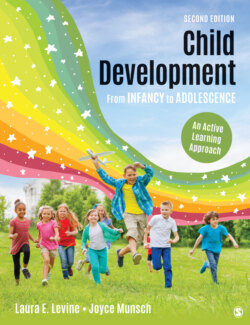Читать книгу Child Development From Infancy to Adolescence - Laura E. Levine - Страница 144
На сайте Литреса книга снята с продажи.
Observations
ОглавлениеWe can learn a great deal about anything we are interested in, including development, by making careful observations. Scientific observations differ from our casual, everyday observations of the world because they need to be both systematic and objective and must be carefully planned and executed if they are to be valid.
Making observations in naturally occurring settings allows us to see children behaving as they normally do within the social relationships that shape their development every day of their lives, and we see them in situations that have real emotional significance for them (Dunn, 2005). A detailed record of everything that happens in a stream of behavior can make researchers aware of aspects of behavior they haven’t noticed before and can be a good source of new hypotheses for future research. However, recording everything that happens even in a fairly short period of time produces a tremendous amount of raw data that needs to be analyzed and reduced before useful information emerges, so researchers may use checklists to collect data. While observing the child, they simply mark the presence or absence of each item on the checklist or count how many times each behavior occurs. Checklists can assess many aspects of development, including social skills, physical skills, language development, and problem behaviors. They are a quick way to compare a child’s development to the development of other children and to keep track of children’s progress as they grow and develop, so they are often used in educational, medical, and other settings that require quick, efficient assessment of a child’s level of functioning.
Checklist: A prepared list of behaviors, characteristics, or judgments used by observers to assess a child’s development.
Although naturalistic observations are very useful sources of information about behavior, they have some limitations. If researchers are testing their own hypotheses, there is a risk that they might pay more attention to observations that tend to support those hypotheses and overlook those that don’t. This tendency is called observer bias . Having more than one observer code or score the observations helps assure us that the observations are objective rather than subjective. Another safeguard is to use observers who don’t know the specific hypothesis being tested (that is, observers who are “blind” to the hypothesis) so that it cannot affect their perception of the events they are observing.
Observer bias: The tendency for an observer to notice and report events that he is expecting to see.
T/F #7
When conducting research by doing an observation, it is important that the person who is doing the observation does not know the purpose of the research. True
Scientific observation. Carefully conducted observations, either in natural settings or in a laboratory, can give us insight into behavior as it naturally occurs.
Billy Hustace via Getty Images
Also, the mere presence of an observer might change the way people behave. Children usually adapt to the presence of an observer without too much difficulty, but video recorders can be used so that the child does not see the observer. A limitation of naturalistic observational research is that it doesn’t tell us directly about the causes of behavior. To examine causes of behavior, researchers must be able to control the conditions of the children they are studying. You will learn more about what allows a researcher to conclude that one variable is the cause of certain outcomes when you read about research designs later in this chapter.
